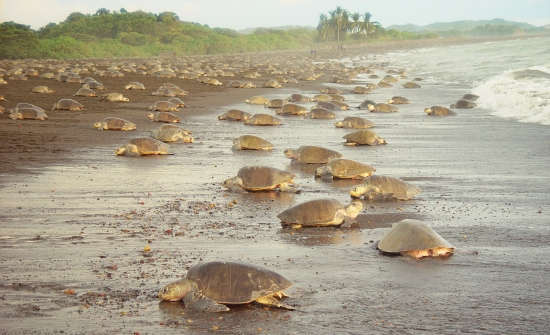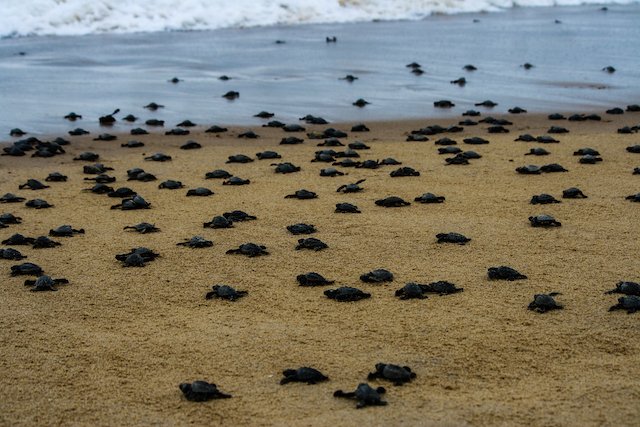Sea turtles hatch in Costa Rica typically from July to December. The warm sand helps incubate the eggs until hatching.
Costa Rica is a prime nesting ground for various species of sea turtles, attracting thousands of visitors annually to witness this natural wonder. The country’s pristine beaches serve as vital habitats for these majestic creatures, where they lay their eggs and later witness the tiny hatchlings making their way to the ocean.
The peak hatching season, from July to December, offers a unique opportunity for eco-tourists and conservation enthusiasts to observe and support the conservation efforts aimed at protecting these endangered species. Understanding the timing of sea turtle hatchings in Costa Rica allows visitors to plan their trips to witness this incredible phenomenon firsthand.

Credit: costaricaexperts.com
Sea Turtle Nesting Seasons In Costa Rica
Costa Rica is a renowned destination for witnessing the spectacular sight of sea turtles hatching along its pristine shores. Understanding the nesting seasons of these majestic creatures is crucial for experiencing this natural wonder up close.
Different Species Of Sea Turtles
Costa Rica is home to various species of sea turtles, including the Olive Ridley, Green, Leatherback, Hawksbill, and Loggerhead turtles. Each species has its unique nesting habits and can be observed at different times of the year.
Nesting Beaches In Costa Rica
Costa Rica boasts several nesting beaches where sea turtles come ashore to lay their eggs. Playa Ostional, Tortuguero National Park, and Playa Grande are among the most popular nesting sites where visitors can witness this incredible natural phenomenon.

Credit: www.goeco.org
Hatching Process
Sea turtles are fascinating creatures, and witnessing the hatching process is a rare and awe-inspiring experience. In Costa Rica, the hatching process of sea turtles is a natural wonder that attracts many visitors to the coastal areas. Understanding the hatching process of sea turtles can provide valuable insights into the conservation efforts aimed at protecting these endangered species.
Incubation Period
The incubation period for sea turtle eggs typically lasts around 45 to 60 days, varying depending on the species. The temperature of the sand plays a crucial role in determining the duration of the incubation period. Warmer temperatures tend to result in shorter incubation periods, while cooler temperatures can prolong the process.
Emergence From The Nest
After the incubation period, the hatchlings begin to emerge from their nests. This usually occurs at night when the temperatures are cooler and there is less risk of predation. The hatchlings use a combination of instincts and environmental cues to guide them towards the ocean. The path from the nest to the water is perilous, with many obstacles and predators along the way.
Factors Affecting Hatching
Sea turtle hatchlings in Costa Rica are influenced by various factors affecting their hatching times. These include temperature, humidity, and the depth at which the eggs are buried in the sand. The hatching process usually occurs during the nighttime to maximize the hatchlings’ chances of survival.
Sea turtles are fascinating creatures, and their nesting season in Costa Rica is a sight to behold. One of the most exciting moments is when the eggs hatch, and the baby turtles make their way to the ocean. However, the hatching process is affected by various factors, and it’s essential to understand them to ensure the survival of these endangered species. The three main factors affecting hatching are the temperature of the sand, predation, and human interference.Temperature Of The Sand
The temperature of the sand plays a crucial role in determining when the eggs will hatch. The sex of the hatchlings is determined by the temperature of the sand. Warmer temperatures produce more females, while cooler temperatures produce more males. The ideal temperature for hatching is between 28 and 32 degrees Celsius. If the temperature goes beyond this range, it can have severe consequences on the hatchlings. High temperatures can lead to developmental abnormalities, while low temperatures can delay hatching, making the hatchlings vulnerable to predators.Predation And Human Interference
Predation and human interference are other factors that affect hatching. Predators such as crabs, birds, and snakes can prey on the eggs or hatchlings, reducing the survival rate. Human interference, such as beach development, can also impact the hatching process. Bright lights and loud noises can disorient the hatchlings, leading them away from the ocean and into danger. It’s important to limit human activity and protect the nesting sites to ensure that the hatchlings have a better chance of survival. In conclusion, the hatching process of sea turtles in Costa Rica is a delicate and complex process. The temperature of the sand, predation, and human interference all play a role in determining the survival rate of the hatchlings. By understanding these factors, we can take measures to protect these magnificent creatures and ensure their survival for generations to come.
Credit: www.nytimes.com
Conservation Efforts
The conservation efforts for sea turtles in Costa Rica are crucial to protect these endangered species and ensure their survival for future generations. Costa Rica has implemented various protective measures and actively involves local communities in the conservation efforts.
Protective Measures
Costa Rica has established protected areas and national parks along its coastlines to provide safe nesting habitats for sea turtles. These areas are strictly monitored to prevent poaching and disturbance to nesting sites. Additionally, laws and regulations have been put in place to prohibit the trade of sea turtle products and protect these animals from harm.
Community Involvement
Local communities play a significant role in sea turtle conservation efforts in Costa Rica. Conservation organizations work closely with these communities to raise awareness about the importance of protecting sea turtles and their nesting grounds. Through education and outreach programs, the communities are empowered to actively participate in conservation activities, such as beach clean-ups and monitoring nesting sites.
Conclusion
In Costa Rica, sea turtles hatch between July and December, a mesmerizing natural spectacle. Conservation efforts are crucial to protect these endangered species. Witnessing these tiny creatures make their way to the ocean is a heartwarming experience. Plan your visit during the hatching season for a memorable adventure.






Leave a Reply